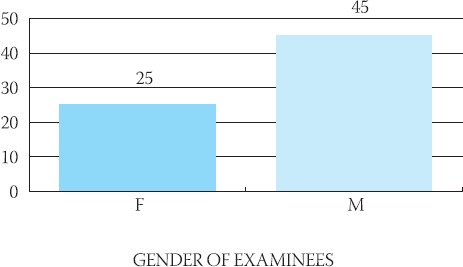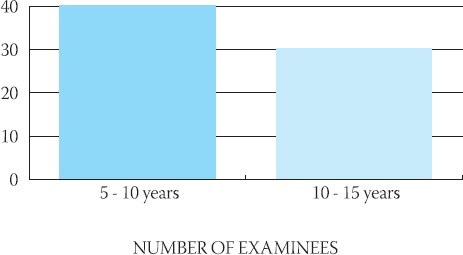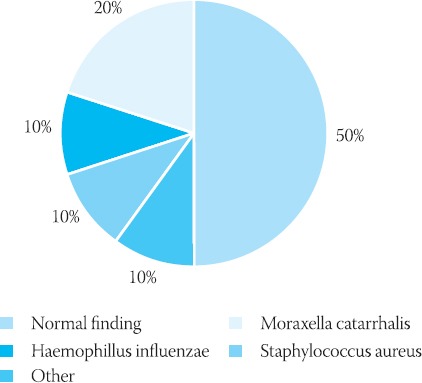Abstract
In this prospective study we compared the efficiency of azithromycin and amoxicillin-clavu-lanate in treatment of acute sinusitis in children. Seventy patients were included in the age between 5 and 15 years. Beside ENT and pediatricians examination, nasal and throat smear on culture and antibiogram is taken from all the patients, as well as, X-ray of paranasal sinuses and laboratory findings, followed by check-up of nasal and throat smear and X-ray of paranasal sinuses. Azithromycin in single daily dose of 10 mg/kg during three days showed same efficiency as amoxicillin-clavulanate given three times per day in dose of 45 mg/kg during ten days.
Keywords: acute sinusitis, children, azithromycin, amoxicillin-clavulanate
INTRODUCTION
The treatment of acute sinusitis in childhood is, in most cases, based on antibiotic treatment (1). Even minimally invasive sinus surgery with aim to widen natural ostium doesn’t have a lot of supporters in our country (2, 3). Since the swelling of paranasal sinuses mucosa is very often in children and combined with the infection of upper respiratory tract, we conducted this study with goal to compare the efficiency of azithromycin and amoxicillin-clavulanate in the treatment of acute sinusitis (4, 5).
PATIENTS AND METHODS
This research made in concordance of recommends from Good Clinical Practice guidelines (GCP) involving human subjects and material derived from human subjects complied with ethical principles outlined in World Medical Association Declaration of Helsinki Ethical Principles for Medical Research Involving Human Subjects. The children treated in outpatient department were included in this prospective clinical study. Total number of children is 70, 45 male and 25 female in the age between 5 and 15 years. Beside ENT and pediatricians examination, nasal and throat smear on culture and antibiogram is taken from all the patients, as well as, X-ray of paranasal sinuses and laboratory findings. In the patients where positive bacteriological finding in the nose and X-ray obvious sinusitis (maxillary sinus was predominant site of inflammation) were encountered, we applied azithromycin in single daily dose of 10 mg/ kg during three days or amoxicillin-clavulanate given three times per day in dose of 45 mg/kg during ten days with ephedrin hidrochloride nasal decongestive solution twice a day. 10-15 days following treatment we did checkup nasal and throat smear and X-ray of paranasal sinuses.
RESULTS
Observed groups of examinees included 45 patients, treated with azithromycin and 32 with amoxicillin/ clavulanate, among them 40 patients received full dosage of azithromycin and 30 od amoxicillin clavulanate. Seven patients did not show up on follow up examination (Table 1). Total number of observed children was 70, 45 male and 25 female (Graph 1). Age distribution was: 40 between 5-10 years, 30 between 10-15 years. In all observed groups we took nasal and throat smear, culture and antibiogram which showed normal finding in 50%, Moraxella catarrhalis was isolated in 20%, Hae-mophillus influenzae in 10%, Staphylococcus aureus in 10%, other bacteria were islolated in 10% of patients. We analyzed X ray findings at the first examination, as well as tenth day of treatment. According to sinus location, maxillary sinus prevailed (Table 2). There was good response on azithromycin therapy in maxillary sinus infection as evident on X rays (10th day of treatment). In some cases therapy effect was evident after 20 days.
TABLE 1.
Observed group of examinees

GRAPH 1.

Incidence according to gender
TABLE 2.
X-ray findings

GRAPH 2.

Incidence according to age
GRAPH 3.

Bacteriological findings
FIGURE 1.

X-ray findings before (a) and after (b) treatment with azithromycin
DISCUSSION
Both antibiotics were well tolerated. The incidence of adverse events was low in both treatment groups; there were no significant differences between azithromycin and amoxicilin/ clavulanate. There also were no severe adverse reactions attributable to either agent. Treatment with azithromycin in a single dose of 10 mg/kg during three days showed same efficiency as amoxicilin/ clavulanate which has been applied three times per day during ten days in a dose of 45 mg/ kg. Since all the patients had follow up check 10-15 days after treatment we couldn’t make a conclusion regarding when, actually, the improvement occurred. Bacteriological eradication at the end of treatment was similar comparing both groups. X-ray verified improvement or recovery was similar in both groups, too.
CONCLUSION
Azithromycin in a single day dose during three days has the same efficiency as amoxicillin/ clavulanate applied three times per day during ten days in the treatment of acute sinusitis.
REFERENCES
- 1.American Academy of Pediatrics – Medical Specialty Society: Clinical practice guideline: management of sinusitis. Pediatrics. 2001;108(3):798–808. doi: 10.1542/peds.108.3.798. [DOI] [PubMed] [Google Scholar]
- 2.Parsons DS. Chronic sinusitisa medical or surgical disease in: Otolaryngol. Clin. North. Am. 1996;29(1):1–8. [PubMed] [Google Scholar]
- 3.Scott R, Schoem G, Zalzal GH. Sinusitis in children. Current Opinion in Otolaryngology & Head & Neck Surgery. 1999;7:1419. [Google Scholar]
- 4.Hadley JA. The role of medical management in rhinosinusitis. Current Opinion in Otolaryngology & Head & Neck Surgery. 2001;9:11–16. [Google Scholar]
- 5.Johnson PA, Rodriguez HP, Wazen JJ, et al. Ciprofloxacin versus Cefuroxime axetil in the treatment of acute bacterial sinusitis: J. Otolaryngol. 1999;28(1):3–11. [PubMed] [Google Scholar]


